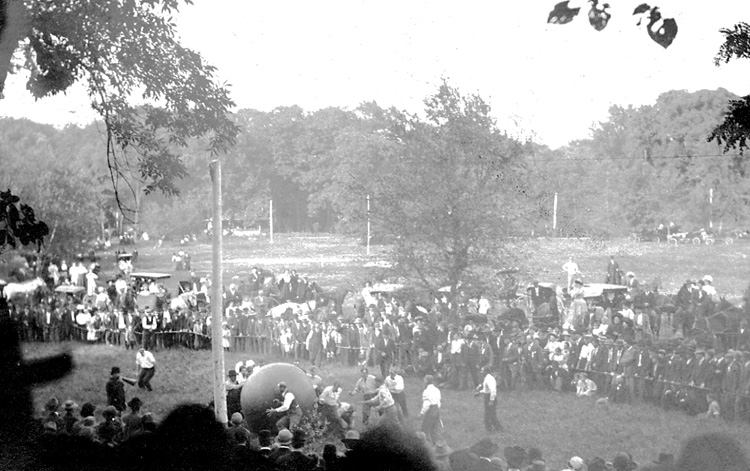
A
“farmer’s pushball contest on Farmers Day . . . at the city park about a
mile out of town”
is displayed by a 1909 postcard which bears the explanation its reverse
side.
The 50-pound rubber ball which is six feet in diameter is visible just left of
center in the
foreground of this card from the Hibbs postcard collection.
|
By
Bob Hibbs
City
Park was “a mile out of town” in the opinion of the writer of a 1909 note
on a postcard displaying the image of a “farmer’s pushball contest on
Farmers Day.” The writer, who signed as “Wm.,” probably referred to the
approximate distant to the business district since actual corporate boundaries
were relatively unimportant then.
The
University of Iowa President’s House, which looks down on City Park from the
south, was built that same year, so urban development actually wasn’t far
from the park.
Before
1909 folks accessed this new 78-acre City Park using the 1876 Centennial
Bridge at Iowa Avenue, then used what now is North Riverside Drive to Koontz
Avenue, now renamed Park Road. Sold to the city in 1906 by the Terrell and
Sanders family, the park was later expanded northwest to its present 105-acre
size.
The
first river bridge at Park Road was a triple-span high truss built the year
before the postcard was mailed. It was replaced by the present four-lane
concrete span built in 1960 immediately north of the original span, which
creates the angular jog in the street alignment at the west end of today’s
bridge.
Controversy
erupted at the new Park Road bridge in 1911 when steel was delivered to the
adjacent upstream riverbank for an adjacent Iowa City Electric Railway bridge.
Trolley tracks already ran north from the downtown in Dubuque Street for
service which turned east along Church Street to Oakland Cemetery at Center
Street.
Tracks
were to be extended from Church Street north in Dubuque Street two blocks to
the bridge site, then cross the river to serve the park and a developing
Manville Heights neighborhood. With arrival of the steel, area residents
quickly developed a severe case of what today is called “nimby,” meaning:
not in my back yard.
One
bridge was enough, Bella Vista residents claimed in 1911, and as a result the
steel rusted on the riverbank four years while a compromise ran the tracks
across the existing structure. The steel was then sold.
The
pushball postcard, a recent addition to the Hibbs collection, carries a
one-cent stamp cancelled at Iowa City on Oct. 10, 1909. It’s addressed to
Waverly, and is an actual photographic print rather than an engraved image
printed on a press.
The
event probably was sponsored by the Iowa City Commercial Club, the predecessor
organization to what now is called the Chamber of Commerce. The earlier club
was housed upstairs in a building located mid-block of Washington Street
between Clinton and Capitol streets near what now is the north entrance to Old
Capitol Mall.
The
Guzeman’s Garage sold Chevrolets on the main floor of the building back
then.
Pushball
is played on a large field – officially 140 yards by 50 yards wide – using
an inflated rubber ball which is six feet in diameter and weighing in at 50
pounds. Goals looking much like football goalposts sometimes were used, with
posts 20 feet apart and a crossbar 18 feet above the ground.
The
game was played informally just moving the ball to the ends of the field with
as many playing on each side as wanted to participate. Official rules called
for 11 on each team; and, if goals were available, scoring was five points for
passing the ball under the crossbar, or eight points for getting it over the
bar.
Invented
in 1894 by one M.G. Crane of Newton, Massachusetts, it was sometimes played on
horseback. It was first popular at Harvard University, and was played as a
freshman verses sophomore contest in Iowa City during the dawning years of the
20th century.
Pushball
at the park, anyone?
Next
Saturday: Horse power for Jessup
Hall. Bob Hibbs collects local postcards and other historic ephemera and researches history related to them.
|